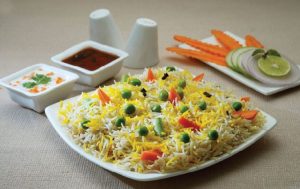 There is nothing like a good plate of aromatic biryani! This Vegetable Biryani hits all the right spots with its wonderful aroma and exotic flavors! Loaded with veggies, crunchy cashews, warm spices like saffron, herbs like cilantro and mint, this biryani is a delight to the taste buds in every bite!
There is nothing like a good plate of aromatic biryani! This Vegetable Biryani hits all the right spots with its wonderful aroma and exotic flavors! Loaded with veggies, crunchy cashews, warm spices like saffron, herbs like cilantro and mint, this biryani is a delight to the taste buds in every bite!
What is Biryani
Biryani is a rice dish made with layers of rice, spices and traditionally meat (but it our case veggies!).
The key components:
Rice: It is the base and key ingredient of this dish. Long grain basmati rice is what is traditionally used.
Veggies: Assorted vegetables such as potato, cauliflower, beans and carrots are required. Green peas, mushrooms or even paneer would be a good addition.
Spices: Aromatic and exotic spices (both whole and ground) are a must for a good biryani. Most commonly used are cardamom, peppercorns, cumin, saffron, garam masala. Also rose water or kewra water is often used to flavor the biryani.
Fresh herbs & nuts: herbs like mint, cilantro and nuts like cashews are often added as garnishing and to add more texture and flavors to the biryani.
Caramelized onions also make a great addition. The veggies and rice are layered and the biryani is then cooked on low heat with some heavy object placed on top of the pot of biryani.This process is called “dum” and hence it’s also known as Vegetable Dum Biryani.
How to make it
Choose the right rice: Long grain basmati rice is what you should be using to make biryani.
Using fresh ingredients: like mince your own fresh ginger, garlic and chilies.
Pan-frying the veggies before cooking them: So before cooking the veggies, pan fry them a little. This gives the veggies a nice texture.
Using fresh herbs & spices: All the herbs and spices add flavor to biryani. Saffron milk a mixture of saffron and warm milk and rose water may be used for the final flavor. Cilantro and mint further enhance the taste.
Drizzle ghee on top: Drizzle some extra ghee on top before cooking the biryani at the last step.
Method
Cook the rice
Soak the rice in 3 cups (24 oz) water for 30 minutes. After the rice has soaked, drain the water using a colander.
1. Heat a pot full of water, add 3 green
cardamom, 2 cloves and 3/4 teaspoon salt to it. Let it come to a boil.
2. Add rice, stir with a spoon.
3. Let it cook uncovered (don’t lower the heat) until it’s almost cooked (around 70-75% cooked but not fully cooked). There should be a bite to it. This takes around 6 to 7 minutes.
4. Remove pan from heat and drain rice in a colander. You may add a teaspoon of ghee to the rice. Set aside.
5. Heat 1.5 tablespoons ghee in a pan on medium heat. Once hot, add 1 sliced onion to it and cook until they turn golden brown and caramelize. This takes around 8 to 9 minutes. Remove on a plate.
6. To the same pan, now add cashews and cook until golden brown, around 1 to 2 minutes. Remove on plate and set aside.
7. To same pan add potato, cook for 2 minutes until light brown. Remove it.
8. To the same pan, now add cauliflower, beans and carrots. Saute for 2 to 3 minutes until veggies appear light brown. Remove on a plate.
9. Heat 2 tablespoons milk in a pan. Once warm, add saffron strands (crush it
before adding). Let it sit for 10 minutes for that beautiful yellow color. Saffron milk is ready, set it aside.
10. Crush ginger, garlic and chili using a mortar and pestle. Set aside.
11. Heat 1.5 tablespoons oil in a pan/pot on medium heat. Add cumin seeds, cinnamon stick, bay leaf, peppercorns, remaining 3 cardamom and remaining 2 cloves. Stir and let the spices sizzle for few seconds. Add the sliced onions also add 1/4 teaspoon salt.
12. Cook for 3 to 4 minutes until onions turn light brown. Then add the crushed ginger-garlic and green chilies paste. Cook for 2 minutes until the raw smell goes away.
13. Remove pan from heat and whisk in the yogurt, whisking continuously until it’s all absorbed. Put the pan back on heat. Add all the veggies and toss to combine.
14. Add the biryani masala and kashmiri red chili powder.
15. Add 1/4 cup water. Let it cook for around 6 to 7 minutes until veggies are almost cooked but not overcooked. They should be firm to bite. You may also cover the pan, I usually cook uncovered. There shouldn’t be much water left, it should be kind of thick mixture. Remove from heat.
16. Now take a heavy bottom pan. I first grease the bottom of the pan with ghee.
17. Then add a layer of rice (half of the rice).
18. Top with half of fried onion, half of fried cashews and half of cilantro and mint. Add 1/2 teaspoon of rose water.
19. Now place the veggies on top (all of it).
20. Then add the remaining rice on top of the veggies. Then top it with remaining with fried onion, cashews, cilantro and mint. Add the prepared saffron milk on top.
21. Add the remaining 1 teaspoon rose water on top.
22. And finally drizzle 1 teaspoon ghee on top. Sprinkle some biryani masala.
23. Make 2 layers of rice and 1 layer of veggies. If your pan in small you may do more layers, but the end layer should always be of rice. Cover the pan tightly with aluminium foil. Then cover with a fitted lid. Heat a flat pan on medium heat. Once hot, reduce the flame to lowest. Place your biryani pot on top of the pan and let it cook for 25 to 30 minutes on lowest heat (dum). Scoop out the biryani from the bottom of the pan so that each serving has both the veggies and the rice. Serve vegetable biryani with a side of raita.
letters@tehelka.com












